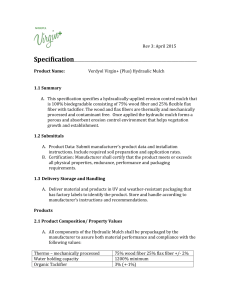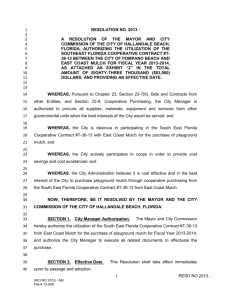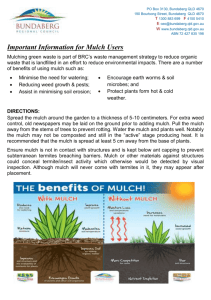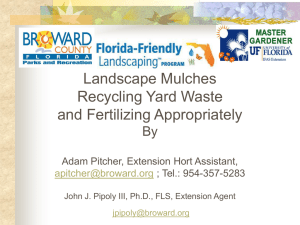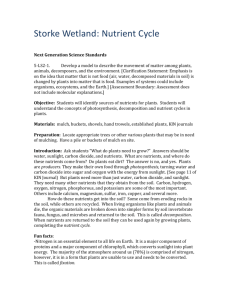Mesh Bag Mulch Extraction, Storage, and Dilution Plating
advertisement
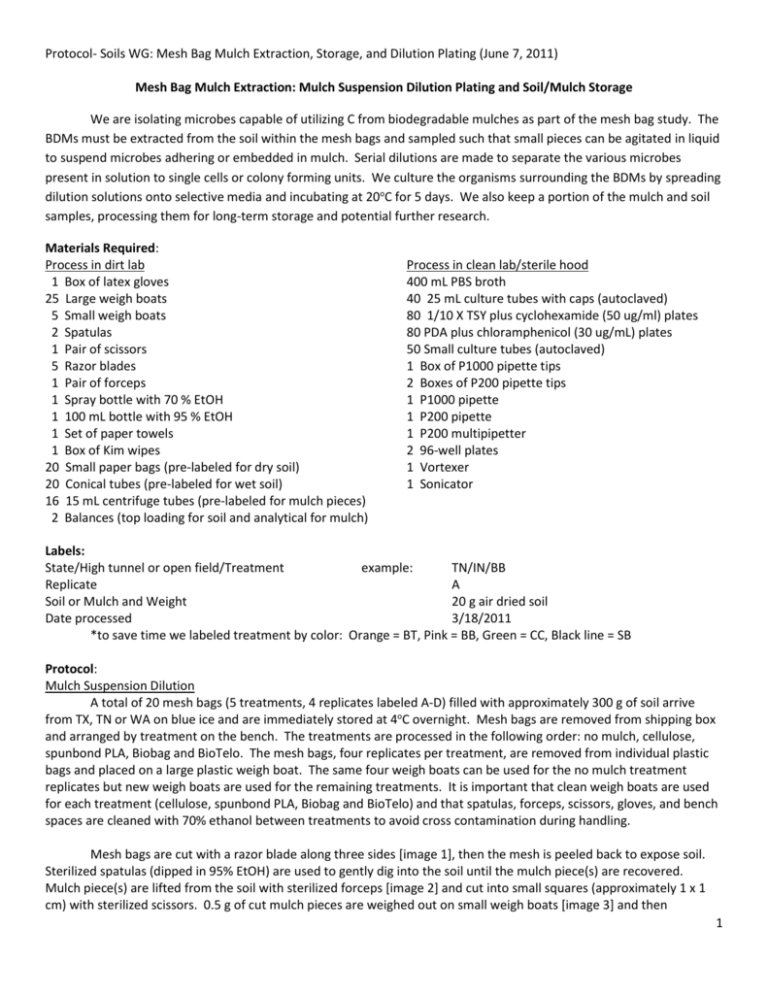
Protocol- Soils WG: Mesh Bag Mulch Extraction, Storage, and Dilution Plating (June 7, 2011) Mesh Bag Mulch Extraction: Mulch Suspension Dilution Plating and Soil/Mulch Storage We are isolating microbes capable of utilizing C from biodegradable mulches as part of the mesh bag study. The BDMs must be extracted from the soil within the mesh bags and sampled such that small pieces can be agitated in liquid to suspend microbes adhering or embedded in mulch. Serial dilutions are made to separate the various microbes present in solution to single cells or colony forming units. We culture the organisms surrounding the BDMs by spreading dilution solutions onto selective media and incubating at 20oC for 5 days. We also keep a portion of the mulch and soil samples, processing them for long-term storage and potential further research. Materials Required: Process in dirt lab 1 Box of latex gloves 25 Large weigh boats 5 Small weigh boats 2 Spatulas 1 Pair of scissors 5 Razor blades 1 Pair of forceps 1 Spray bottle with 70 % EtOH 1 100 mL bottle with 95 % EtOH 1 Set of paper towels 1 Box of Kim wipes 20 Small paper bags (pre-labeled for dry soil) 20 Conical tubes (pre-labeled for wet soil) 16 15 mL centrifuge tubes (pre-labeled for mulch pieces) 2 Balances (top loading for soil and analytical for mulch) Process in clean lab/sterile hood 400 mL PBS broth 40 25 mL culture tubes with caps (autoclaved) 80 1/10 X TSY plus cyclohexamide (50 ug/ml) plates 80 PDA plus chloramphenicol (30 ug/mL) plates 50 Small culture tubes (autoclaved) 1 Box of P1000 pipette tips 2 Boxes of P200 pipette tips 1 P1000 pipette 1 P200 pipette 1 P200 multipipetter 2 96-well plates 1 Vortexer 1 Sonicator Labels: State/High tunnel or open field/Treatment example: TN/IN/BB Replicate A Soil or Mulch and Weight 20 g air dried soil Date processed 3/18/2011 *to save time we labeled treatment by color: Orange = BT, Pink = BB, Green = CC, Black line = SB Protocol: Mulch Suspension Dilution A total of 20 mesh bags (5 treatments, 4 replicates labeled A-D) filled with approximately 300 g of soil arrive from TX, TN or WA on blue ice and are immediately stored at 4oC overnight. Mesh bags are removed from shipping box and arranged by treatment on the bench. The treatments are processed in the following order: no mulch, cellulose, spunbond PLA, Biobag and BioTelo. The mesh bags, four replicates per treatment, are removed from individual plastic bags and placed on a large plastic weigh boat. The same four weigh boats can be used for the no mulch treatment replicates but new weigh boats are used for the remaining treatments. It is important that clean weigh boats are used for each treatment (cellulose, spunbond PLA, Biobag and BioTelo) and that spatulas, forceps, scissors, gloves, and bench spaces are cleaned with 70% ethanol between treatments to avoid cross contamination during handling. Mesh bags are cut with a razor blade along three sides [image 1], then the mesh is peeled back to expose soil. Sterilized spatulas (dipped in 95% EtOH) are used to gently dig into the soil until the mulch piece(s) are recovered. Mulch piece(s) are lifted from the soil with sterilized forceps [image 2] and cut into small squares (approximately 1 x 1 cm) with sterilized scissors. 0.5 g of cut mulch pieces are weighed out on small weigh boats [image 3] and then 1 Protocol- Soils WG: Mesh Bag Mulch Extraction, Storage, and Dilution Plating (June 7, 2011) transferred to 25 mL culture tubes containing 9.5 mL of PBS broth [image 4]. If the mulch has been completely degraded or you are processing the no mulch treatment add 0.5 g of soil from the center of the mesh bag (choose pieces that are still discolored from the residual mulch) to the broth. 2 1 [ T y p e 3 4 The culture tubes containing 9.5 mL PBS broth and 0.5 g mulch are vortexed for 30 sec at high speed, sonicated for 10 min [image 5], and vortexed again for 30 sec. The meniscus of your solution should be just below the cap while a vortexing. This is achieved by holding the tube tightly at the desired meniscus height, keep one finger slightly pressed q on top to prevent solution from spilling over [image 6]. The agitation should achieve two goals: 1) suspend microbes in u solution by breaking up biofilms and physically removing cells imbedded or adhering to mulch pieces and 2) create a o homogeneous solution so that cultures are an accurate reflection of what microbes are present (culturable on selected t media) [image 7]. e 5 f r o m 6 7 t h e The microbial solution is concentrated and must be diluted in order to obtain individual cells or colony forming units (pure cultures); therefore, serial dilutions are done in a laminar flow hood [diagram 1]. d o Diagram 1: Mulch solution dilution process c u m re n The dilution process is broken down into steps below t Well 1: Well 2: Well 3: Well 4: Well 5: 450 uL 450 uL 450 uL 450 uL 450 uL o PBS & PBS & PBS & PBS & PBS & r 50 uL 50 uL 50 uL 50 uL 50 uL from from from from from t tube 2 well 1 well 2 well 3 well 4 h 1: Tube 2: Tube 4.5 mL 9.5 e mL PBS & 0.5 g s mulch u m m a r PBS & 0.5 mL from tube 1 2 Protocol- Soils WG: Mesh Bag Mulch Extraction, Storage, and Dilution Plating (June 7, 2011) Tubes 1 and 2 may be prepared the night before (filled with 9.5 and 4.5 mL PBS, respectively), autoclaved and pre-labeled. It is important to mix each tube/well before completing each dilution transfer. Microbes will drop out of the solution and then CFU counts and isolates will not accurately reflect what is in the mulch suspension. 0.5 g mulch is weighed into Tube 1 (9.5 mL of PBS solution), making a 20-fold dilution (5.0 x 10-2). After sonication and vortexing (above) 0.5 mL of solution is transferred to the 4.5 mL PBS in culture Tube 2 [image 8], making a 5.0 x 10-3 dilution. The remaining 10-fold dilutions are all made by adding 50 uL of the previous dilution to the next microplate well, which contains 450 uL PBS. Thus, well 5 in the microplate will be a 5.0 x 10-8 dilution. In all, two dilution tubes and four microplate wells are used for each sample. Mixing in between dilutions is done by vortexing culture tubes for 30 sec or by pipetting the liquid in the microplate wells up and down ten times (vortexing, unless very gentle, is liable to spread droplets from one sample well to another and contaminate them). 8 9 Be sure to check pipette tips for air bubbles and amount differences before unloading. WRONG WRONG CORRECT For efficient diluting, first make all culture tube dilutions (5.0 x 10-2 and 5.0 x 10-3) and then transfer 50 uL from Tube 2 into Well 1 for sample replicates A-D. Use a multipipetter to carry out remaining transfers [image 9]. Use one set of pipette tips to transfer 50 uL of mixed solution from Well 1 to Well 2, unload the multipipetter, and use new tips to mix solution in well 2 and so on [diagram 2]. Well solutions are mixed by pipetting solution up and down: pipette up solution, place tips along the side of the well, release solution so that it flows down the well wall and back into solution, and repeat ten times. Diagram 2: 96-well plate mixing procedure Well 1: slowly pull up solution and release down well wall After well is mixed 10 times transfer 50 uL to next well and repeat mixing process 3 Protocol- Soils WG: Mesh Bag Mulch Extraction, Storage, and Dilution Plating (June 7, 2011) After dilutions are made (Tube 1 to Well 5), 100 uL of the mulch suspension is transferred onto selective media [image 10]. Fungal isolates are obtained by plating 100 uL from Tube 2 and Wells 1-3, and spread onto potato dextrose agar plates containing chloramphenicol (30 ug/mL). Bacterial cultures are obtained from Wells 2-5 and spread onto 1/10 X trypticase soy yeast agar containing cycloheximide (50 ug/mL). The agar plates are pre-labeled and placed in the hood one day before dilutions are made. Air dries out the agar, allowing the mulch suspension to seep in. The diluted mulch suspension should be quickly spread so that growth is uniform across the plate. Small culture tubes can be autoclaved and used to quickly spread the solution [image 11 ]. The same spreader and pipette tips can be used to transfer and spread dilutions if you start with the most diluted well and work towards the less diluted well/tube. 10 11 The plates are stored upright for 30 minutes to let liquid soak in, then inverted, and incubated at 20oC in dark for 5 days. Dilution plates will be counted [image 12] and isolates from the dilution plates will be streaked onto BDMs to test for potential biodegradation capability (see first BDM test protocol). 12 WA/IN/BB fungal dilution plates from Tube 2 (5.0 x 10-3) and Well 1 (5.0 x 10-4) Soil and Mulch Long Term Storage Soil and mulch pieces for long term storage are also prepared in the dirt lab during mulch extraction from mesh bag replicates. An additional 0.5 g of mulch is transferred to a 15 mL conical tube for permanent storage (-20oC). There are 4 replicates so each treatment will have 4 tubes containing mulch labeled A-D. Two soil samples are also prepared for permanent storage, approximately 20 g of wet soil is weighed twice [image 13]. The first 20 g is stored wet in a conical tube, the second 20 g of soil is transferred to a paper bag, air dried in a chemical fume hood for 7 days, sealed with tape, and stored in ziplock bags. Mulch and soil samples are stored at -20oC, soil samples are kept in labeled ziplocks and double bagged [image 14]. 4 Protocol- Soils WG: Mesh Bag Mulch Extraction, Storage, and Dilution Plating (June 7, 2011) 13 14 5
